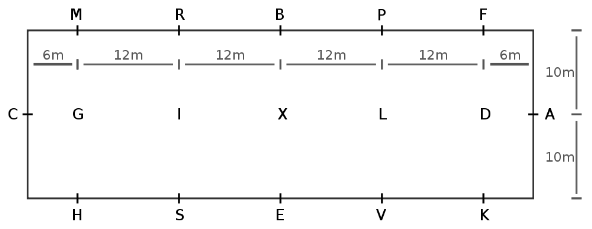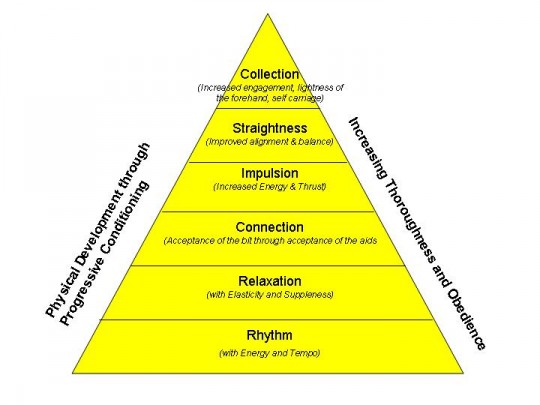Emerald Vista Equestrian Ranch
Main menu:
Dressage
Disciplines

Dressage is a French term, translated to mean "training". What appears beautiful and effortless to the observer is in fact an achievement in art and athleticism requiring many years of development and dedication from both horse and rider. Dressage is what many people consider Horse Ballet.
Dressage is performed in a 20 x 60 meter arena with a set of letters that designate where movements are to be executed.
Regulation Dressage Arena

Early European aristocrats displayed their horses' training in equestrian pageants, but today successful dressage training is demonstrated through the performance of highly structured competetive tests. Judges evaluate each movement on the basis of an objective standard appropriate to the level of the test and assign each movement a score from zero to ten - zero being "not executed" and 10 being "excellent".
The Training Scale
The dressage training scale is often arranged in a pyramid or sequential fashion, with “rhythm and regularity” at the start of the pyramid and “collection” at the end. The training scale is helpful and effective as a guide for the training of any horse, but has come to be most closely associated with dressage.
The training scale presented below is a translation from German to English and therefore may not be as accurate as it could be.
Rhythm and Regularity (Takt)
Rhythm, gait, tempo, and regularity should be the same on straight and bending lines, through lateral work, and through transitions. Rhythm refers to the sequence of the footfalls, which should only include the pure walk, pure trot, and pure canter. The regularity, or purity, of the gait includes the evenness and levelness of the stride. Once a rider can obtain pure gaits, or can avoid irregularity, the horse may be fit to do a more difficult exercise. Even in the very difficult there is still regularity: the horse "trots on the spot" in place, raising the front and hind legs in rhythm.
Relaxation and Suppleness (Losgelassenheit)
The second level of the pyramid is relaxation (looseness). Signs of looseness in the horse may be seen by an even stride that is swinging through the back and causing the tail to swing like a pendulum. The horse loosens at the poll, soft chewing of the bit, and calmly blows through the nose. The horse also makes smooth transitions, is easy to position from side to side, and willingly reaches down into the contact as the reins are lengthened.
Contact (Anlehnung)
Contact—the third level of the pyramid—is the result of the horse’s pushing power, and should never be achieved by the pulling of the rider’s hands. The rider encourages the horse to stretch into soft hands that allow the horse to lift the base of its neck, coming up into the bridle. The rider should always follow the natural motion of the animal’s head. The horse should have equal contact on both reins.
Impulsion (Schwung)
The energy thrust of the horse is called impulsion, and is the fourth level of the training pyramid. Impulsion is created by storing the energy of engagement (the forward reaching of the hind legs under the body). Impulsion can be demonstrated at the walk, trot, and canter. It is highly important to establish good, forward movement and impulsion at the walk, as achieving desirable form in the trot and canter relies heavily on the transition from a good, supple, forward walk. Impulsion not only encourages correct muscle and joint use, but also engages the mind of the horse, focusing it on the rider and, particularly at the walk and trot, allowing for relaxation and dissipation of nervous energy.
Straightness (Geraderichtung)
A horse is straight when the hind legs follow the path of the front legs on both straight lines and on bending lines, and the body follows the line of travel. Straightness allows the horse to channel its impulsion directly toward its center of balance, and allows the rider’s hand aids to have a connection to the hind end.
Collection (Versammlung)
At the top of the training scale stands collection. It refers to collected gaits and it involves difficult movements (such as flying changes) in more advanced horses. Collection requires greater muscular strength, so must be advanced upon slowly. When in a collected gait, the stride length should shorten, and the stride should increase in energy and activity. When a horse collects, more weight moves to the hindquarters. Collection is natural for horses and is often seen during pasture play. A collected horse is able to move more freely. The joints of the hind limbs have greater flexion, allowing the horse to lower the hindquarters, bringing the hind legs further under the body, and lighten and lift the forehand. Collection is the horse's ability to move its centre of gravity to the rear.
Dressage Training Pyramid

Description of Dressage Testing Levels and Performance Expectations
Introductory Level -- all work at this level is done at the walk and trot, with no cantering. Emphasis is on beginning to develop correct bend, relaxation, submission, and the horse's understanding of basic rider aids. Movements required are medium walk, free walk, and rising trot. All work is performed in straight lines, including the long diagonals, and on 20 m circles. The horse is expected to carry himself forward, showing acceptance of the bit and the rider's aids.
Training Level -- is to confirm that the horse's muscles are supple and loose, and that it moves freely forward in a clear and steady rhythm, accepting contact with the bit." Canter work on 20 m circles is added at this level. Either sitting or rising trot may be used when trot work is required. The horse is also asked to stretch down at the trot, and make changes of bend at the trot without breaking to the walk.
First Level -- is to confirm that the horse, in addition to the requirements of Training Level, has developed thrust (pushing power) and achieved a degree of balance and throughness." Trot work on 10 m circles and 20 m serpentines is added, as well as trot lengthenings. Lengthenings are done rising, and later sitting; the remainder of trot work is done sitting. Canter work is on 15 m circles and straight lines, with lengthening also introduced at the canter. Leg yield and change of canter lead through trot are also introduced by the end of the First Level tests.
Second Level -- is to confirm that the horse, having demonstrated that it has achieved the thrust (pushing power) required in First Level, now shows that through additional training it accepts more weight on the hind quarters (collection), shows the thrust required at medium paces and is reliably on the bit. A greater degree of straightness, bending, suppleness, throughness, and self-carriage is required than at First Level." Transitions between medium and collected gaits become important at Second Level. Shoulder in, Travers (haunches in), rein-back, and counter-canter are all added to the tests, as well as simple lead changes in canter.
Third Level -- is to confirm that the horse has achieved the requirements of the Second Level. It now demonstrates in each movement, especially in medium and extended paces and in the transitions to and from collected movements, rhythm, suppleness, acceptance of the bit, throughness, impulsion, straightness, and collection. There must be a clear distinction between the paces." Half pass and flying lead change at the canter are added at Third Level.
Fourth Level -- is to confirm that the horse has achieved the requirements of the Third Level. These are tests of medium difficulty designed to confirm that the horse has acquired a high degree of suppleness, impulsion, throughness, balance, and lightness while always remaining reliably on the bit, and that its movements are straight, energetic, and cadenced with the transitions precise and smooth." Half pirouette at the walk and quarter pirouette at the canter are introduced. Multiple flying lead changes every few strides are added in Test 3.
International Level -- is a dressage tests governed by the FEI. are the Prix St. Georges, Intermediare I, Intermediare II, and Grand Prix. The dressage tests performed at the Olympic Games Dressage competition are Grand Prix. This level of test demands the most skill and concentration from both horse and rider.
Advanced Movements Included in Grand Prix Dressage Tests:
Piaffe - A calm, composed, elevated trot in place
Passage - A movement done at the trot, in which the horse has great elevation of stride and seems to pause between putting down its feet (it has a great amount of suspension in the stride). Described very well like a horse "trotting under water", it takes great strength and training to get a good passage.
Extended gaits - Usually done at the trot and canter, the horse lengthens its stride to the maximum length through great forward thrust and reach. Grand Prix horses show amazing trot extensions.
Collected gaits (trot and canter) - A shortening of stride in which the horse brings its hindquarters more underneath himself and carries more weight on his hind end. This takes a great amount of strength. The tempo does not change, the horse simply shortens and elevates his stride.
Flying changes - informally called "tempi" at this level the horse changes leads at the canter every stride (one tempi or "oneseys"), two strides (two tempi), or three strides (three tempi).
Pirouette - A 360 or 180 (depending on the level) degree turn in place, usually performed at the canter
Half-pass - A movement where the horse goes on a diagonal, moving sideways and forward at the same time, while bent slightly in the direction of movement.
Sample Preliminary Level Dressage Test
